How to Prepare the Absolute Best Veal Marsala
Veal Marsala is a classic Italian dish that showcases tender veal cutlets simmered in a rich and savory Marsala wine sauce. This elegant yet approachable recipe is perfect for home cooks who want to create a restaurant-quality meal with minimal effort.
The key to Veal Marsala’s distinctive flavor lies in the combination of earthy mushrooms, sweet Marsala wine, and a touch of garlic, which perfectly complements the delicate veal. Whether preparing a special dinner for guests or simply elevating your weeknight cooking, this dish is a crowd-pleaser.
One of the best things about Veal Marsala is its versatility. It can be served with various sides, such as pasta, mashed potatoes, or a simple green vegetable, making it easy to adapt to your preferences or the occasion. Plus, with just a few ingredients and a straightforward cooking process, you don’t have to be a professional chef to master it.
In this post, I’ll walk you through the essential steps to prepare a flavorful Veal Marsala that’s sure to impress. From selecting the proper cut of veal to achieving the perfect sauce consistency, you’ll have all the tips you need for success.
Chef Ricco Deluca's Help
I learned this veal marsala recipe from my friend Chef Ricco Deluca, who has forgotten more about cooking Italian food than I’ll ever know. Ricco grew up in a family of cooks, including his mom, who was Frank Sinatra’s family cook for over 15 years.
I wanted to know how to make the best veal Marsala, so I asked Ricco for his recipe and asked him to give me everything he could think of to make this the best veal Marsala recipe ever. I questioned why he did something this way and why others were that way. The final result is filled with many details that only a real foodie would enjoy.
For those who want the recipe without all the detailed explanations, I’ve included it below. But if you want to know why Chef Ricco cooks the mushrooms separately from the rest of the dish, you’ll want to check out the other parts of the story.
I’ll discuss different ingredients like salted or unsalted butter, what type of veal, and why demi-glace. Ricco and I discussed cooking equipment, including what kind of pan to use and what size. We also discussed cooking techniques and adjustments to make while preparing this dish.
You may think it is information overload, but this is what I love about cooking. I don’t just want to know what to do, when to do it, and how long to do it; I want to know WHY.
And remember to check out my recipe for Chicken Marsala here.
Veal Marsala Perfected
Ingredients
- ½ tablespoon butter
- ½ tablespoon oil
- 6 veal cutlets or scaloppini
- 1 medium shallot minced
- 1 sprig of thyme
- ¼ cup Marsala
- ¼ cup demi glace
- salt and white pepper to taste
For the mushrooms
- 2 teaspoons butter
- 2 teaspoon olive oil
- 3 large mushrooms sliced
Instructions
- Start by getting everything ready. This, in French, is called “mise en place.” It is essential to have everything ready for this dish because things happen quickly, and if you are holding up chopping shallots while the veal is cooking, something will go wrong.
- Mince your shallot, chop your thyme, and have everything prepped before you even think about heating a pan.
Prepping the Veal
- If you own a meat-tenderizing mallet with a waffled side for tenderizing and a flat side for flattening, it is an excellent time to get it out of the drawer. If you don’t have a mallet, try using a rolling pin or a can of soup.
- Give each piece of veal a whack with the tenderizing side, then cover them with some clear plastic wrap and flatten them with the flat side, so they are all the same thickness. This will help break up the membrane from this cut of veal and make them more tender.
Cooking Technique
- Heat your pan over medium heat to get it hot, and then add half your butter and oil. When the butter and oil are hot but not smoking, sauté three veal cutlets for just one minute per side. Then, remove them from the pan and reserve them on a plate but don’t cover them.
- You don’t cover them because they are thin and hot and will continue to cook off the heat. If you cover them in foil, they will steam and get rubbery. You will add them back to the pan at the end, so don’t worry about them getting cold.
- You want to be sure to save any accumulated juices that come from the cutlets to add back to the sauce.
- Repeat this process with the other three cutlets.
Making the Sauce
- Discard any oil in the pan, if there is any, and reduce the heat to medium. Add the shallot, thyme, salt, and pepper, and cook for 1 minute. When Ricco gave me this instruction, my first question was, “How can you cook shallots in a dry pan?”
- His response was to keep stirring so the ingredients don’t burn and don’t leave the stove. In time with lots of practice, he reminded me, it becomes second nature. If you are concerned about burning the shallot, leave some residual oil from cooking the veal cutlets.
- Add ¼ cup of Marsala wine and reduce to half. Next, add 1/4 cup of demi-glace, stir, and correct seasonings by tasting to see if it needs more salt or pepper. How will you know? This is something you learn by doing.
Making Adjustments
- I have found that if whatever I am cooking is bland, a little bit of salt will perk it up. However, you must be careful here because if the sauce is hot, your taste buds won’t taste anything. Try using a spoon to taste the sauce but be sure to blow on it to cool it off before you make any adjustments.
- You can also taste for sweetness at this point. If the sauce doesn’t have that wonderful Marsala flavor, you can add a touch of Marsala but again, be careful not to overpower the taste.
Mounting
- Reduce the sauce just a little and finish it by adding a tablespoon of cold butter. The restaurant term for this process is “mount,” which means to whisk cold butter into a warm sauce for added flavor, smoother texture, and more sheen.
- If you are adding more than one tablespoon, it is essential to add them piece by piece making sure the first one is fully incorporated before adding the next. If you add all the butter at once, you risk the chance of the sauce separating into liquid and fat. This is called “breaking.”
Finishing Up
- Add the veal back to the pan for 30 seconds to 1 minute to reheat, incorporate the flavors and warm it up. Serve it immediately with a side of pasta or a simple rice dish.
What About Mushrooms?
- I’ve always associated Veal Marsala with sliced mushrooms, so I asked Chef Ricco to give me some ideas and pointers on adding them to his recipe. He explained that in many restaurants, they typically cook the mushrooms right in the sauce to save time and reduce the number of dirty pans, but he likes to cook them separately for a couple of reasons:
- Mushrooms give off a lot of liquid that he doesn’t want in his sauce.
- By cooking them separately, they won’t taste like the rest of the dish. This way, you add an additional layer of flavor to the recipe.
- How does he serve them? He likes to serve the mushrooms as a garnish on top of the dish after it’s been sauced. Alternatively, he might add them back to the saucepan right before serving.
- Be sure to get the mushrooms started before you begin cooking the veal. You don’t want to mess around with mushrooms while making the Marsala sauce.
Preparing mushrooms to serve with Veal Marsala
- Clean, fresh mushrooms with a damp cloth or paper towel. Never soak them in water; they will absorb the water like a sponge and be soggy.
- Thinly slice the mushrooms, and then sauté them in a bit of butter and oil. You want to cook them until they are just tender.
- Season with salt and pepper.
- Remove from pan and reserve. If you add them back to the sauce before serving, don’t worry about them getting cold.
- If you are going to serve on top of the veal as a garnish, cover and keep warm.
What Ingredients Do I Need to Make Restaurant Quality Veal Marsala?
What I want to do here is to start looking at this recipe in more detail. When I asked Ricco for his recipe, I was much more novice than I am today and had many questions. I wanted to know what he did in his recipe and why he did it. I also like to know what products he used and why they mattered.
Veal Marsala Recipe Ingredients
There are few ingredients in the Very Best Veal Marsala Recipe, but what you use can make a difference in the final product. So here are the ingredients in Ricco’s recipe and why he likes to use them.
What is the best cut of veal for this recipe?
You want the thin, lean, boneless cutlet or scaloppini that comes from different muscles in the leg.
Butter - Salted or Unsalted?
It’s best to use unsalted butter so you can control the amount of salt. You can and will adjust the seasonings at the end, but it’s easier to add salt and impossible to remove if it’s oversalted.
Clarified butter would work great with this dish, but it takes extra time and effort unless you have some in your refrigerator.
What type of oil?
Use 90% canola oil blended with 10% olive oil. Chef Ricco explained that many professional chefs use a blend of oils because canola oil has a higher smoking point, while olive oil adds flavor.
Besides, as much as I love the taste of olive oil, you want its flavor to be balanced with the flavor of the meat and Marsala.
Why use both oil and butter?
I like using a combination of butter and oil because the butter adds flavor, while the oil, with its higher smoking point, allows you to cook at a higher temperature. Heat is your friend when sautéing, so the combination provides the best cooking fats.
Why coat the cutlets with flour?
Although Ricco likes the flavor of veal Marsala better without flour, he suggests using it for the following reasons:
- After tenderizing the meat, it will bleed, and the flour will help seal it in.
- Unless you will immediately serve the veal from the pan to the plate and eat it immediately, the flour crust will hold in some of the juices and, therefore, flavor.
- The flour will hold more of the sauce to the veal.
- Some people enjoy the “mouth feel” associated with a flour-created crust.
What is seasoned flour?
If you take some flour and add salt and pepper to it, you have seasoned flour. Chef Ricco likes to make a batch of seasoned flour and store it in a container in his pantry. This way, he always has some on hand whenever he needs to coat something for sautéing.
To make a batch for yourself, combine 2 cups of all-purpose flour with one teaspoon of salt & 1 teaspoon of pepper.
You can experiment with different seasonings to create your unique blend, but don’t get too carried away, or you will have a pantry filled with too many flour containers.
What is demi-glace?
Demi-glace is a brown sauce reduction essential in making classic sauce. A simple way to describe demi-glace is to say it is a rich brown sauce reduced to a thick gelatinous consistency.
Culinary students spend much time in cooking school learning to make stocks, stock reductions, and glaces like demi-glaces. Professional chefs often have a large pot of veal and beef bones simmering day and night to make the stuff. You can find a good recipe for making it at home at demi-glace.
What is Marsala?
Marsala is a fortified wine imported from Sicily. It can be used for cooking or drinking. At your local liquor store, you can find it in dry and sweet flavors. I prefer to cook with dry-flavored wine. Marsala is dark amber in color and has a distinctive smoky flavor.
You don’t have to buy the most expensive bottle of Marsala, but stay away from the cheapest. You especially want to avoid the fake Marsala cooking wine in supermarkets. It’s not worth the bottle they put it in.
You may want to use what you don’t cook with as an aperitif, a light alcoholic drink that is often served before dining to stimulate the appetite.
What is a shallot?
Shallots are members of the onion family. They are much smaller than traditional-looking onions and have a paper-thin brown skin covering purple-tinged white flesh. They have a combination of onion-garlic flavors but are milder than either one.
You can find them at most supermarkets, usually next to the garlic. Look for well-shaped heads that are not sprouting. You will find them in various sizes, so buy according to your recipe.
What is white pepper?
White pepper comes from the same dried berry as black pepper, the Poper nigrum, but when producing white pepper, the berry is allowed to ripen so the outer skin shrinks entirely and is removed. The remaining grayish-white kernel has a milder flavor than black pepper.
It is typically used in lighter-colored dishes where you don’t want the color of black pepper to contrast with the sauce. You see, white pepper is used a lot in cream sauces.
What Type Of Cooking Pan For Veal Marsala?
This section looks at the best cookware for making this dish at home, but these are only suggestions from Chef Ricco. They are by no means absolute requirements.
If your kitchen is equipped with other cookware, don’t feel like you have to go out and buy additional pans to make this dish. Instead, use what you have and adapt your cooking to your tools.
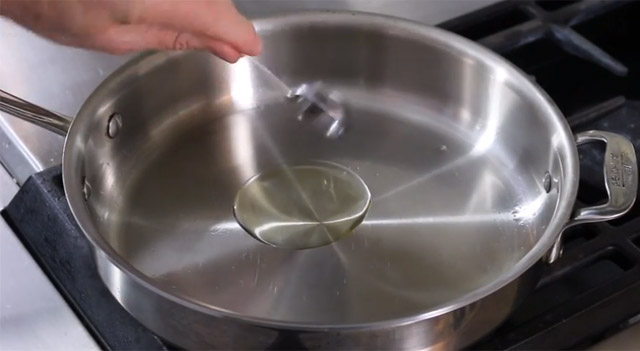
What type of cooking pan and what size?
Ideally, Chef Ricco recommends using an 8 – 10 inch sauté pan or frying pan and cooking three at a time. Never crowd a pan when sautéing, or the meat will steam rather than fry properly.
Besides, you will add the meat back to the pan to reheat when the sauce is done.
Why not just use a 14-inch pan and cook them all simultaneously?
I had a question about using my large frying pan. Ricco explained:
- A smaller pan holds heat better, especially on smaller home stovetops. Large 14-inch pans work well in commercial kitchens with high-BTU stoves. But most home stoves don’t have enough power to heat big pans properly or keep them hot.
- All pans, like ovens, have hot spots. Larger pans create bigger hot spots, leading to uneven cooking.
- Smaller pans handle heat more efficiently. They maintain proper temperatures for better cooking. When you add meat to a hot pan, the pan cools down temporarily. Chef Ricco always reminds me, “Heat is your friend when cooking.” A smaller pan bounces back faster from sudden temperature drops.
- On my stove, larger pans don’t fit the burners well. So, for now, I stick with smaller pans until I can upgrade to a new stove.
What about non-stick-coated pans?
Not a good idea for this dish. We want the pan to get hot and create a fond (the brown bits stuck to the pan after sautéing, also called sucs) that will add flavor to the sauce. It doesn’t work well with nonstick pans because nothing sticks to the pan to create fondness.
Does the frying pan material matter?
Copper
Experienced cooks love copper pots and pans for their excellent heat conductivity. Turn up the heat, and copper heats up quickly. This works great if you know what you’re doing, but it’s easy to overcook or burn food without paying close attention.
Another advantage of copper is its even heating. Copper pans don’t have hot spots, so the entire pan cooks evenly.
They also look beautiful, but there’s a trade-off. Copper cookware is expensive and requires a lot of maintenance to stay in top shape.
Stainless Steel
Stainless steel is an excellent choice for this dish. The veal will stick slightly, creating a fond—flavorful base for a pan sauce. Many people prefer nonstick pans because they don’t want food to stick. That makes sense for foods like eggs and fish. But when making a pan sauce, stickiness is an advantage.
Stainless steel is also more affordable than copper. It doesn’t conduct heat as quickly, making it easier for beginner and intermediate cooks to manage. Plus, stainless steel requires much less upkeep. Many brands are dishwasher-safe, making cleanup easy.
Stainless steel is also versatile. Unlike copper or aluminum, it doesn’t react to acidic foods.
The downside is its heat conductivity. Stainless steel doesn’t distribute heat as evenly as copper, so you’ll get more hot spots. But with careful cooking, you can work around that.
Aluminum and Hard Anodized Aluminum
So, what’s the difference? Anodized aluminum means manufacturers place aluminum in chemical baths. Then, they apply an electrical charge. This process thickens the oxide layer, making it stronger, harder, and less likely to corrode.
I love hard-anodized aluminum pans. They conduct heat well—better than stainless steel but not as well as copper. Plus, they’re tough. They’re twice as hard as stainless steel and much more durable than regular aluminum. You can toss them around on the stove or in cabinets without much worry.
These pans also perform well. They heat quickly and evenly, though not as fast as pure aluminum. Maintenance is simple. When I started teaching myself to cook 25 years ago, I bought anodized aluminum pots and pans. I still use them, but they’ve started to warp, so I’m slowly replacing them.
Here’s the downside: all anodized aluminum pans today are nonstick. I haven’t found any that aren’t. This frustrates me because I want some foods to stick. It helps me make great pan sauces.
I know little about pure aluminum pans, but I decided to try them. I found a restaurant supplier and bought a few. They conduct heat exceptionally well, cost less than stainless steel or copper, and are standard in professional kitchens.
But there’s a catch. Pure aluminum reacts with acidic foods and can leach into the dish. Research on this issue goes both ways. I recommend doing your homework before buying any pan, regardless of material. That’s where I’ll leave it.
Blends
I just purchased this incredible Vollrath 3 Quart Saute Pan from an online restaurant supply store I love. It has a 3-ply construction with an 18-8 stainless interior and an aluminum core to provide even heat on the bottom of the pan and side walls. With a silicone-coated handle that is oven-safe to 450°F, it feels great in my hand; I can’t wait to see how it performs.
Another blend is copper with stainless steel; I’m sure there are others. Depending on your budget and cooking needs, there’s something for everyone.
Bottom Line
The best pan for making this dish is the one you have in your kitchen cabinet. You’ll do better if you use a pan that is not nonstick, but if all you have is nonstick, don’t let that stop you from making this veal Marsala perfected. If you plan to make more pan sauces, you can purchase one of the pans I described above.
The Quick & Easy Version of Veal Marsala
If you are already proficient in the kitchen or are not that particular about the details, here’s Chef Ricco’s Veal Marsala Recipe with no explanations. They are easy to follow and will produce a fantastic dish for two people. Of course, if you want to serve more, adjust the recipe for four or more people.
You can find veal already scallopini style, which means pounded thin into quick-cooking servings, but if you can’t, you can purchase veal cutlets and pound them yourself with a meat pounder or the bottom of a heavy cooking pan.
Ricco likes to cook the mushrooms separately from the sauce and serve them as a garnish when plating or add them to a saucepan right before serving.
Simplified Veal Marsala Recipe
Ingredients
- 3 tablespoons butter
- 1 tablespoon oil
- ¼ pound mushrooms clean and thinly sliced
- 6 veal scallopini cutlets depending on cutlet size or your appetite.
- 1 medium shallot minced
- 1 sprig of thyme finely chopped
- salt and white pepper to taste
- ¼ cup Marsala
- ¼ cup demi glace
Instructions
- Prep the veal if necessary so you end up with 6 thin scallopini styled cutlets.
- Before you start cooking the veal, prep the mushrooms and saute in 1 tablespoon of butter until just tender. Transfer to a plate and reserve.
- Heat a frying pan large enough to cook all 6 cutlets over medium-high heat. If you don't have a pan big enough to accommodate all 6, cook the cutlets in batches of 3.
- Add the oil & 1 tablespoon of butter to the pan.
- While the butter melts and the oil heats up, dredge each cutlet in seasoned flour. Be sure to shake off all excess or the flour will burn and stick to the pan.
- Pan fry the cutlets for approximately 1 minute per side. Transfer the veal to a plate and cover with foil to keep warm.
- Discard remaining oil in the pan and reduce heat to medium.
- Add shallot, thyme, salt and pepper and cook for 1 minute. Remember to keep stirring so nothing burns.
- Add Marsala wine and reduce by half.
- Add demi glace, stir and cook until the sauce is thick enough to coat the back of a spoon. At this time I like to add the remaining tablespoon of butter to the pan. It's called mounting and helps "finish" the sauce.
- At this time, I may add the previously cooked mushrooms back to the pan to reheat in the sauce or I may just add them to the top of veal as a garnish. You decide.
- Taste and correct seasonings with salt & pepper.
- Transfer the cooked veal cutlets back to the pan to reheat before serving. I like to spoon the sauce over the cutlets at this time while they are heating up.
- Serve with pasta or rice and a favorite vegetable side dish.

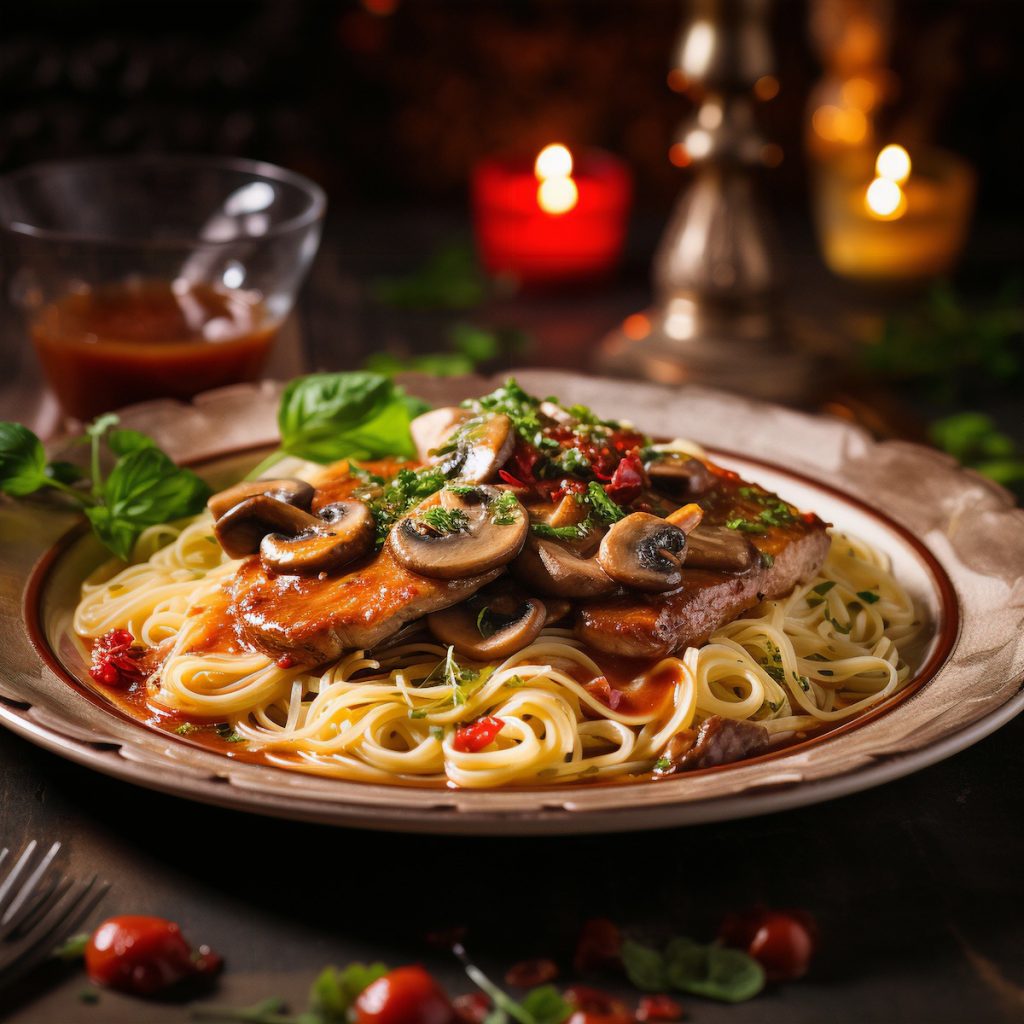
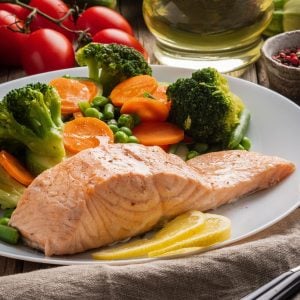
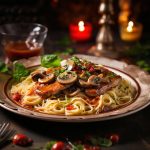
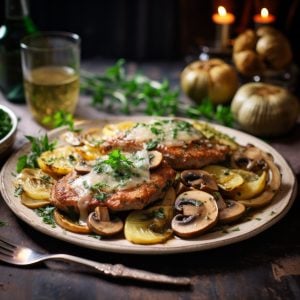
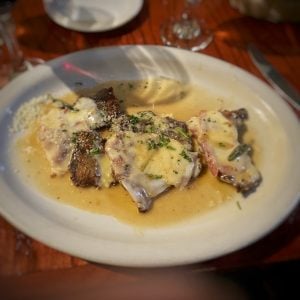
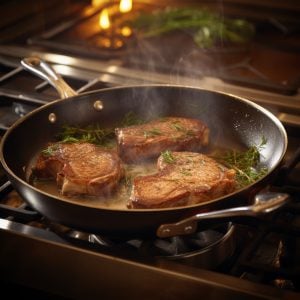
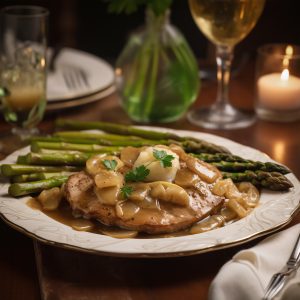
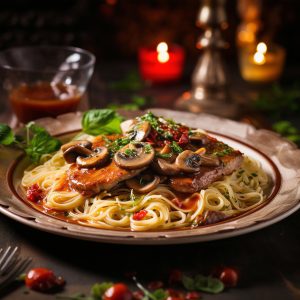
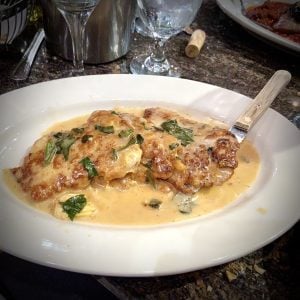
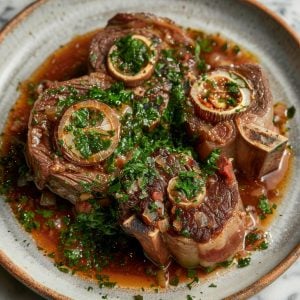
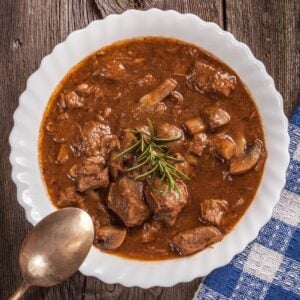


7 Responses
Hey Stephen! I am just finding your blog. There is so much great information on here, thanks for taking the time! I have a question about cooking the shallots in a dry pan. What is the benift of cooking them this way? Am I correct in assuming you want to brown them without burning? Does this method extend to cooking vegetables in general or just for onions and garlic to start preparation for a sauce?
Hi Brian, great question and I don’t have an answer. I asked Chef Ricco how to cook the shallot in a dry pan but I should have asked him WHY. I personally never cook a shallot, garlic or onion in a dry pan and always use a little oil, butter or both. Unfortunately, I have not been able to track Ricco down for a number of years to ask him. When I did a quick search, I found there is such a think as roasting a shallot in a dry pan. It takes 15 to 20 minutes to roast and they are not chopped or minced but they do give the shallot a “smoky dimension” which I guess is what Ricco is looking for and he is one of the best cooks I’ve ever met so I won’t argue. If you are more comfortable, by all means, add a little oil to saute the shallots.
Thanks Stephen! I appreciate your thoughtful reply. I like the idea of adding that “smokey dimension” to my dishes. I’ll give it a try for an extra layer of flavor.
Cheers!
I found your article very helpful. In preparing this dish prior to reading your article I found my dish lacked the signature Marsala flavor. I used moderately priced dry Marsala in the sauce, but while delicious, it lacked that flavor that I make this dish for. What could be the problem?
Anne, that would be very difficult for me to figure out without tasting the dish. You don’t want the sauce to be overwhelming Marsala but you may want to try a little more next time and see if this makes a difference.
The details talk about coating the veal in flour but I don’t see any steps in the actual recipe to do this.
Hi Karen, although the details talk about coating the veal with flour, Chef Ricco prefers the taste without it and did not include it in his recipe. I’ll fix that by making it optional. You would flour the veal just before adding to the frying pan. Try flouring a couple, leave the others flour-free, and see which you prefer.